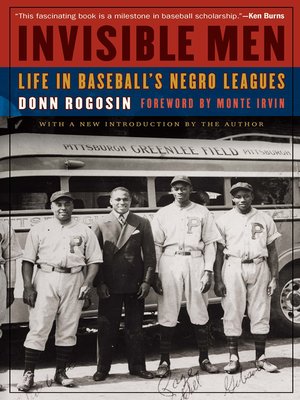
Sign up to save your library
With an OverDrive account, you can save your favorite libraries for at-a-glance information about availability. Find out more about OverDrive accounts.
Find this title in Libby, the library reading app by OverDrive.



Search for a digital library with this title
Title found at these libraries:
| Library Name | Distance |
|---|---|
| Loading... |
On Feb. 13, 1920, a group of independent black baseball team owners held a meeting at a YMCA in Kansas City, Missouri. While they couldn't have known at the time that they were about to change the course of American history, it was out of that meeting that the Negro National League was born.
The league flourished throughout the 1920s and beyond, becoming the first successful, organized professional black baseball league in the country. By providing a playing field for African American and Hispanic baseball players to showcase their world-class baseball abilities, it became a force that provided cohesion and a source of pride in black communities. Among them were the legendary pitchers Smokey Joe Williams, whose fastball seemed to "come off a mountain top," Satchel Paige, the ageless wonder who pitched for five decades, and such hitters as Josh Gibson, Buck Leonard, and Oscar Charleston, whose talents as players may have even been surpassed by their total commitment to their profession and hardiness. Leading the leagues were memorable characters like Gus Greenlee of the Pittsburgh Crawfords and Effa Manley of the Newark Eagles.
Although their games were ignored by white-owned newspapers and radio stations, black ballplayers and their teams became folk heroes in cities such as Chicago, Kansas City, Pittsburgh, Philadelphia, New York, and Washington DC, where the teams drew large crowds and became major contributors to the local community life, with influence extending far beyond the baseball fields. This memorable narrative, filled with the memories of many surviving Negro League players, pulls the veil off these "invisible men" who were forced into the segregated leagues. What emerges is a glorious chapter in African American history and an often overlooked aspect of our American past.
The league flourished throughout the 1920s and beyond, becoming the first successful, organized professional black baseball league in the country. By providing a playing field for African American and Hispanic baseball players to showcase their world-class baseball abilities, it became a force that provided cohesion and a source of pride in black communities. Among them were the legendary pitchers Smokey Joe Williams, whose fastball seemed to "come off a mountain top," Satchel Paige, the ageless wonder who pitched for five decades, and such hitters as Josh Gibson, Buck Leonard, and Oscar Charleston, whose talents as players may have even been surpassed by their total commitment to their profession and hardiness. Leading the leagues were memorable characters like Gus Greenlee of the Pittsburgh Crawfords and Effa Manley of the Newark Eagles.
Although their games were ignored by white-owned newspapers and radio stations, black ballplayers and their teams became folk heroes in cities such as Chicago, Kansas City, Pittsburgh, Philadelphia, New York, and Washington DC, where the teams drew large crowds and became major contributors to the local community life, with influence extending far beyond the baseball fields. This memorable narrative, filled with the memories of many surviving Negro League players, pulls the veil off these "invisible men" who were forced into the segregated leagues. What emerges is a glorious chapter in African American history and an often overlooked aspect of our American past.







